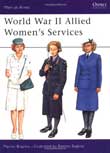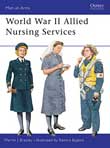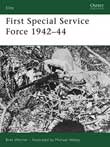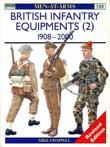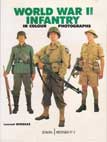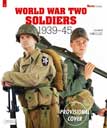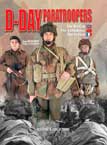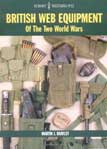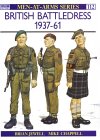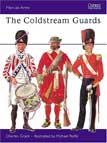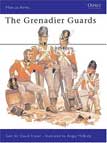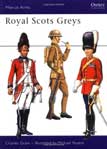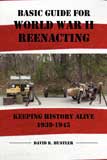

The contribution of women to the Allied war effort during World War II (1939-45) was massive. Apart from their many vital roles 'on the home front', about a million Soviet, 500,000 British and 200,000 American women, and tens of thousands from other Allied nations, served in uniform with the armed forces. To put these figures in perspective: enough American women served to free sufficient able-bodied men to form 15 infantry divisions. It was not only in the USSR that their duties took them into harm's way; hundreds of British Commonwealth and US servicewomen died, and many were decorated. This book gives a concise introduction to the organisation and uniforms of these services, with an emphasis on the British and US forces.
The skill and care of the women of the Allied military nursing services was remembered gratefully by hundreds of thousands of wounded servicemen of World War II (1939-1945). The small peacetime services increased rapidly by enrolling reservists and volunteers; the great majority of the nurses who cared for Allied casualties were 'civilians in uniform', who worked tirelessly under difficult conditions and - in tented hospitals close to the front lines - in real danger; many nurses paid for their devotion with their lives. This first-ever fully illustrated study of the US, British, Commonwealth, and other nursing organisations includes many unpublished photographs and 24 meticulously illustrated colour figures.
Osprey's examination of the First Special Service Force of the second half of World War II (1939-1945). This famous unit was formed with three battalions in July 1942, for special operations in occupied Norway, from handpicked US and Canadian volunteers who were trained in parachute, amphibious, ski, mountain and demolition operations and other 'Special Forces' skills. Their training base was Fort Harrison, Montana. In the event the Force first saw combat in Italy. There they distinguished themselves, at heavy cost, in the battles of La Difensa (Dec 1943), Mte Majo (Jan 1944), on the Anzio beachhead (Feb - May 1944) and in the race to Rome, which they actually liberated. Their uniforms, clothing and weaponry had many unique features reflecting their bi-national composition and specialist skills.
The FSSF fought with a ferocious skill which earned them a fearsome reputation. At Anzio, although at only half strength, they successfully held at least a quarter of the entire beachhead and were the spearhead of the final breakout towards Rome. Famed for their night-time fighting ability, the Germans named them "Die Schwartze Teuflen" the Black Devils (they blacked their faces with boot polish). However, after taking part in the South of France campaign in Aug - Nov 1944 the Force was disbanded, survivors passing to other units. 1,800 men at full strength, they had accounted for 12,000 enemy casualties, taken 7,000 prisoners and experienced a 600% attrition rate.
The author retired from the British Army after serving in the period when much of this materiel was in use. Mastering the adjustment of the pattern 1908 and its descendent the pattern 1937 was a feat but once the set was adjusted, its robust construction and simplicity served to keep it from so readily catching and tangling as does US equipment of the period. Even though this covers the four major sets, 1908, 1937, 1944, and 1958 in detail, the lack of as many variations as in US accoutrements and load bearing equipment (LBE) allows the major parts to be covered. By now, the LBE system of the British soldier has gone through another cycle of design to an internal design pack made of nylon cloth compared with the cotton duck and woven webbing of the predecessors.
This edition has been replaced by one which covers up to 2000 but since the book size is the same, something had to give in the later one.
Examines the uniforms, insignia, personal equipment and weapons of the fighting men of all major armies of World War II. Rare, original uniforms and equipment are modelled and photographed from a variety of angles. Each example is accompanied by text identifying the items illustrated.
Cutting edge when it was new--still worth having!
Presented here in this eighth Militaria guide are detailed color illustrations of the uniforms and equipment of combat infantrymen of WWII, displayed on live models.
Only authentic pieces from several private and public collections have been chosen for this work, and are presented on the man as they were carried on the battlefield.
Each of these 31 soldiers, Polish, Belgian, French, German, British, Italian, Russian and North American, is photographed from the front and back to reveal every detail and accompanied by detailed captions.
The very first ground actions linked to the D-Day in France were fought by the 'red berets', the famous British and Canadian paratroopers of the 6th Airborne Division dropped over the Caen region, but also the lesser-known French SAS who jumped over Brittany the same day to fight a guerilla war. This book offers every detail of these elite soldiers.
The outbreak of WW1 in 1914 found the British Army unready in many respects for a new age of warfare. However, the British led the world in the personal equipment worn by the infantryman thanks to an American officer named Anson Mills and the skills of the company created to produce his design—the 1908 equipment set made in woven cotton web. By the outbreak of WW2, the British infantry had new 1937 pattern equipment, whose design reflected a new generation of weapons and tactics. This proved unequal to the special demands of jungle warfare in the Far East: so 1944 saw yet another set of kit. In this book the author offers collectors and students of militaria a detailed review of these infantry equipments which spanned the British soldier's combat experience throughout most of the 20th century.
To honor the 70th anniversary of D-Day, this superlatively photographed book tells the story of the landings through more than 200 key objects carried by the men who launched the campaign. Selected for their importance to the outcome, and often arranged exactly as the participants' kits were, the artifacts include uniforms and personal mementos of such Generals as Eisenhower and Patton; blueprints of the Mulberry harbors; personal mementos of the US Rangers on Omaha Beach and British Airborne troops at Pegasus Bridge; K-rations and cigarettes, and even rare German Army and Waffen SS material collected from the Normandy battlefields. International in scope, the book covers the US, UK, Canadian, Polish, Free French, and French Resistance, along with Axis soldiers.
On 1 July 1881 Viscount Cardwell's wholesale reorganisation of the British Army brought into existence Princess Louise's Argyll and Sutherland Highlanders. Both had existed as separate regiments even before their official incorporation into the British Army and on the face of it, this seemed a highly improbable union, Being separated both geographically and historically - they had never even served together in the same theatre. Yet, as history has shown, this unlikely combination proved to be a tremendous success. With the help of contemporary accounts and black and white illustrations and photographs, William McElwee tells the story of this most famous of regiments, from the historical origins of both, to their amalgamation and subsequent service in two world wars and beyond. With numerous illustrations and eight superb full page colour plates by Michael Roffe.
Originally Churchill’s second choice as a commander, Montgomery was to make the 8th Army his own. Indeed, his first task as the new commander-elect of was to restore the morale of the army. The desert army quicly assumed the character of their forthright and cocksure commander, and the troops confidently expected victory. This they achieved at the Battle of El Alamein and the order of battle for the British and Dominion forces is detailed in full. The difficulties of desert warfare and the type of equipment and uniforms are also discussed.
This book examines the history, organisation, uniforms and equipment of Montgomery's army during the North African campaigns of World War 2. Major battles and weapons are all covered, and uniforms are shown in full colour artwork.
Canada was the first Commonwealth country to send troops to Britain in 1939. During 1939-45 hundreds of thousands of Canadians - more than 40 per cent of the male population between the ages of 18 and 45, and virtually all of them volunteers - enlisted. Canadians fought with tragic courage at Hong Kong and Dieppe; with growing strength and confidence in Sicily, Italy and Normandy; and finally provided an entire Army for the liberation of NW Europe. This concise account of an extraordinary national effort in the cause of freedom is supported by data tables, photos, and eight colour plates by Canada's most knowledgeable military illustrator.
Looking back from the dawn of the previous century, Canada can be said to have had a turbulent history. Frenchman, Briton, Indian and American revolutionary fought each other in a series of wars which ended with the prize of Canada in British hands. Even then Canada had to contend with periodic internal unrest and threats from beyond its frontiers. British troops were withdrawn in 1871 following Confederation, leaving the defence of Canada entirely in the hands of her own people. By the 1890s this task had been entrusted to a Militia force (said by some to be nothing more than a political gendarmerie), and a woefully small band of regulars. It was in this see-saw atmosphere that Canada, not by any means a military country, was drawn into the first war of the 20th century - an episode that set in motion the sequence of events that was to lead her into two World Wars as well as a number of minor ones. The fascinating history of the Canadian armed forces is here told by Mike Chappell, with numerous contemporary photographs and eight full page colour plates by the author himself.
During the middle years of the Second World War the Royal Air Force constituted the only section of the British armed forces in Europe which was routinely on the offensive. Its aircraft and operations have been voluminously dealt with by historians; but its uniform and flying clothing have received only moderate attention. Whereas service on the ground and in Europe and the tropics definitely required different clothing, this was not necessarily the case with airborne operations. The RAF did not therefore have a set of flying clothing for home service and another for Middle or Far East use. Naturally, aircrew operating during the day at low altitude in North Africa did not need to wear as much as those flying at high altitude at night over northern Europe. Nevertheless there was a surprising commonality of flying clothing across most operational roles, althugh certain items were more likely to be worn by some crews than others - heated clothing, for instance, was if not the exclusive preserve of Bomber Command, at least far more common in that force than elsewhere. Andrew Cormack explores the fascinating history of the uniforms of the RAF throughout the Second World War, in a text accompanied by numerous contemporary photographs and eight full page colour plates by Ron Volstad.
With the introduction of Battledress the British military authorities had every reason to believe they had at last triumphed in a long and arduous struggle to achieve uniformity of dress in the British Army. All soldiers—officers and other ranks, Scots, dismounted cavalrymen, Riflemen, Guardsmen, etc.—would, in Battledress, merge into shapeless anonymity on the battlefield, with nothing but the odd badge or rank to mar authority's dream. As early as October 1939, however, the Commander-in-Chief of the British Expeditionary Force was in communication with the War Office ro recommend that officers' ranking be made more readily distinguishable on Battledress, and pointing out that infantry ésprit de corps would suffer if units were not allowed to wear titles or distinguishing marks. By the New Year of 1940 the War Office had conceded these points to Lord Gort and had agreed in principle to (a) the enhancement of officers' badges of rank with cloth in the colour of the arm-of-service; (b) strips of cloth in the same colours to be worn at the top of the sleeves by all ranks; and (c) the wearing of regimental flashes on Battledress. And so, in late 1940, the rules for the wearing of battle insignia throughout the British Army were established. How far they were obeyed and how often they were ignored will become obvious to anyone reading Mike Chappell's companion work to Men-At-Arms 182, which is illustrated throughout by numerous photographs and eight full page colour plates by the author himself.
At the end of the 1930s more than a few British Army Drill Sergeants must have suffered nightmares after the announcement of a new uniform for the British soldier. Traditional methods are sacred to such men, and their professional world was already shaken by a flood of civilians in uniform and by Mr Hoare Belisha's new barracks. Now they had to accommodate their professional standards to a uniform which resembled a mechanic's overalls, with a huge pocket on the front of the left thigh just where there ought to be a razor-edged crease, and without even any buttons which would take a shine. It is sadly true that many who wore battledress showed a striking resemblance to an animated sack of potatoes. Those with long backs found it impossible to keep the two parts together whenever they had to bend over, this manoeuvre being attended by a pinging of buttons and a rapid cooling of the area above the kidneys. But with all its faults, battledress served its purpose well. It clothed the servicemen of many nations, at war and at peace, for more than 25 years, and did so with reasonable warmth and convenience. Brian Jewell, tells the story of the humble British battledress from 1937-61 in this engaging and readable text which is accompanied by numerous photographs and eight full page colour plates by Mike Chappell.
The importance of the British Army's contribution to World War II - and of World War II in the history of the British Army - is impossible to overstate. This second of three titles devoted to the uniforms and equipment of 1939-45 describes and illustrates the tropical uniforms issued to the legendary 'Desert Rats' of 8th Army and their comrades of 1st Army. It covers the period of Britain's first significant land victory of the war - the crushing defeat of the Italian Army in North Africa in 1940-41; the long, see-saw desert campaign against Rommel's Afrika Korps, 1941-43, during which harsh lessons in modern mechanised warfare were learnt in a series of sobering defeats; and the final decisive victories at El Alamein and in Tunisia. The 8th Army's war was far from over, however; there followed the invasion of Sicily and Italy, 1943; and the bitter struggle northwards through the Italian mountains, against stubborn resistance, which lasted until VE-Day in May 1945.
The Second World War was Britain's last as a world power; it was a citizen's war, in which most British men and women were mobilised. For a year it saw Britain standing alone against the fascist dictatorships; and winning it cost the sacrifice of the entire national wealth. This first title of three describes and explains the uniforms developed for European service. It traces the appearence of the 'Tommy' from pre-war mobilisation, through the years of defeat and endurance, to the final return to Europe on D-Day and the long fighting advance to Northern Germany by spring 1945. Uniform information is supported by a campaign summary, infantry organisation tables, lists of arms and services and basic specifications of a number of heavy weapons.
The Coldstream Guards is the oldest serving regular regiment in the British Army. First called "Monck's Regiment of Foot," the regiment was formed by Oliver Cromwell in 1650, and was later renamed the "Coldstream Guards" after the Scottish village where Monck assembled his troops before marching into London. In the years following the English Civil War, the troops saw action in the Napoleonic Wars, the Crimea, Egypt, Sudan and South Africa, and World Wars I and II. This book outlines the history of the Coldstream Guards from its inception to the end of World War II, detailing the uniforms and equipment of this prestigious unit.
General Sir David Fraser tells the story of this famous regiment; their beginnings, customs, battles and traditions from their formation as 'The Royal Regiment of Guards' in 1656 down to our own times. It is a remarkable story that includes Marlborough's campaigns in the struggle against France, the battle of Waterloo, the Crimean War, and of course two World Wars and beyond. Numerous photographs and illustrations populate Sir David's absorbing text, including eight full page colour plates by renowned military artist Angus McBride, with lengthy commentaries examining in detail the uniforms of the Grenadiers from 1865 to the 1970's.
For almost three centuries the Royal Scots Greys have had the proud distinction of being Scoland’s only regular cavalry regiment, famed for their distinguished service record from Marlborough’s wars to World War II. Indeed, the Greys at Waterloo form one of the most memorable features of military history. With their cry of ‘Scotland forever!’ they charged upon the French ranks seizing the imperial eagle of the French 45th Regimental. This book also looks at how this traditional cavalry unit struggled to come to terms with the realities of modern warfare during the Anglo-Boer war and World War I. Equipment and organisation used in all these combats is detailed in full and uniforms are shown in full colour artwork.
Have you ever been obsessed in war history, particularly about World War II? You have seen reenactments of that significant moment in our time that you are thinking of participating in such an endeavor. However, you don't know how to start.
Fret no more. David Hustler, a veteran of many reenactments of historical battle events, is giving you the head start by imparting tips of the ins and outs of perfecting your own impression of a soldier of the Second World War. He will guide you from buying the proper uniforms and equipments to joining your own group or units, and from the right way of caring for your costume and implements to maintaining a good attitude in the field. Avoid being called a farb on your first day as a reenactor. Follow the expert.
Origin of Christian Era
Roman garrison of Mainz uprising
Gov Lucius Antonius Saturninus of Germany becomes Emperor of Rome
Last gladiator competition in Rome
King Ataulf of Narbonne marries Emperor Honorius sister Galle Placidia
Albrecht II von Habsburg becomes King of Hungary
Portuguese navigators discover Rio de Janeiro
1st day of the Gregorian calendar in Holland and Flanders
Papal Chancery adopts Jan 1 as beginning of the year (was March 25)
Charles II Stuart crowned King of Scotland
Pro-James II-earl of Danby occupies York
Protestant West-Europe (except England) begin using Gregorian calendar
Russia replaces Byzantines with Julian calendar
Great Britain and Ireland union is in effect, creating United Kingdom
Gen George Washington hoists Continental Union Flag
Quakers in Pennsylvania emancipate their slaves
Albany replaces NYC as capital of New York
Russia appoints 1st Jewish censor to censor Hebrew books
Ireland and Great Britain (England and Scotland) form United Kingdom
Congress prohibits importation of slaves
Official reopening of the White House
William Lloyd Garrison publishes 1st issue of abolitionist journal
1st illustrated weekly magazine in US publishes 1st issue, New York City
Michigan is 1st state to abolish capital punishment
Britain takes Mosquito Coast from Nicaragua
City of Glasgow steamer inaugurates Philadelphia-Liverpool line
1st practical fire engine (horse-drawn) in US enters service
Canada begins using decimal currency system
Porfirio Diaz conquers Mexico City
President Lincoln declares slavery in Confederate states unlawful
Battle of Ft McRee, Florida Battle of Port Royal, SC (Port Royal Ferry)
1st homestead under the Homestead Act claimed, near Beatrice, Nebr
Battle of Galveston, Texas-Confederates recapture the city
Emancipation Proclamation (ending slavery) issued by Lincoln
Building of Panama Canal, begins
Cuba liberated from Spain by US (National Day) (US occupies till 1902)
President Theodore Roosevelt shakes a record 8,513 hands in 1 day
South Australia transfers Northern Territory to federal government
Sun Yat-sen forms Chinese Republic
Union of Socialist Soviet Republics established
Russian general Zhukov appointed chief of general staff
US and 25 other countries sign a united declaration against the Axis
Gen Clark replaces General Patton as commander of 7th Army
German air raid on allied airports at Eindhoven / Saint-Trond / Brussels
Emperor Hirohito of Japan announces he is not a god
Ho Chi Minh begins offensive against French troops in Indo China
Massive Chinese / North Korean assault on UN-lines
France returns Saar to becomes the 10th state of German Federal Rep
Sammy Davis Jr marries Loray White
Treaties establish European Economic Community (Common Market)
Castro leads Cuba to victory as Fulgencio Batista flees to Dom Rep
US census at 179,245,000
Houston Oilers beat LA Chargers 24-16 in AFL championship game
Largest check issued, National Bank of Chicago to Sears ($960.242 billion)
Russia introduces a new ruble worth $1.11
Federation of Rhodesia and Nyasaland dissolved
Tonga revises constitution
Netherlands gets color TV
WDCO TV channel 15 in Cochran, Georgia (PBS) begins broadcasting
"The Epoch" (Time 0 for UNIX systems, Midnight GMT)
Afro-American Historical Calendar Series Established
Netherlands Christian Workers Union (NCW) forms
Britain, Ireland and Denmark become 7th-9th members of Common Market
West African Economic Community formed (Benin, Ivory Coast, Mali, Mauritania, Niger, Senegal, Upper Volta)
Haldeman, Ehrlichman, Mitchell and Mardian convicted of Watergate crime
Sweden adopts constitution
President Ford signs 1st major revision of copyright law since 1909
US and China (Peoples Republic) begin diplomatic relations
International Decade of Water & Sanitation begins
Greece is 10th country to join European Economic Community
Palau (Trust Territory of Pacific Is) becomes self-governing
30 Something stars Ken Olin and Patricia Wettig meet, later they marry
Pope John Paul II prays for an end to martial law in Poland
TA launches 5 year capital program to overhaul NYC subway system
Spain and Portugal are 11th and 12th to join European Economic Community
60 bodies recovered in Dupont Plaza Hotel fire in Puerto Rico
New York City transit fare rises from $1.00 to $1.15
David Dinkins sworn in as 1st black Mayor of New York City
FCC implements "SYNDEX" giving independent stations more rights over cable TV outlets for exclusive syndicated programs
Iraq rejects peace proposal from Egyptian President Hosi Mubarak
Bush is 1st US President to address Australian Parliament
Curacao becomes 1st in Dutch Antilles to have compulsory education
Europe breaks down trade barriers
International Space Year begins
12 member European Economic Community set up vast free trade zone
Czechoslovakia separates into Czech Republic (Bohemia) and Slovakia
Microsoft CEO Bill Gates (38) marries Melinda French (29)
North American Free Trade Agreement (NAFTA) goes into effect
"Shadow Box" closes at Circle in the Square Theater NYC after 49 performances
Austria, Finland and Sweden act to join European Union
Fernando Henrique Cardoso installed as President of Brazil
Last "Far Side" by cartoonist Gary Larson (started 1980)
After 27 years, Betty Rubble debuts as a Flintstone vitamin
Curacao gains limited form of self rule (Status Aparte)
All California bars, clubs and card rooms must be smoke-free
US Census Bureau estimates population at 268,921,733
